Experimental Study on Neutral Salt Spray Accelerated Corrosion of Metal Protective Coatings for Power-Transmission and Transformation Equipment
Abstract
:1. Introduction
2. Experimental
2.1. Materials
2.2. Coating Preparation
2.3. Neutral Salt-Spray Test
2.4. Material Characterizations
3. Results and Discussion
3.1. Macroscopic Corrosion Morphology
3.2. Microscopic Corrosion Morphology
3.3. Corrosion Products Analysis
3.4. Adhesion Analysis
3.5. Weight Loss Measurement
3.6. Electrochemical Performance Analysis
4. Conclusions
Author Contributions
Funding
Institutional Review Board Statement
Informed Consent Statement
Data Availability Statement
Conflicts of Interest
References
- Chen, X.F.; Zhang, Z.Y.; Zhang, H.P.; Yan, H.B.; Liu, F.C.; Tu, S. Influence of Air Pollution Factors on Corrosion of Metal Equipment in Transmission and Transformation Power Stations. Atmosphere 2022, 13, 1041. [Google Scholar] [CrossRef]
- Rodger, J.; Bartlett, S.; Atrens, A. Corrosion of the galvanizing of galvanized-steel electricity transmission towers. Mater. Corros.-Werkst. Und Korros. 2017, 68, 902–910. [Google Scholar] [CrossRef]
- Yu, J.S.; Guo, J.K.; Zhao, P.; Lu, L.Q. Environmental corrosiveness evaluation and corrosion charactistics analysis of power transmission and transformation equipment. In Proceedings of the 2014 China International Conference on Electricity Distribution (CICED), Shenzhen, China, 23–26 September 2014. [Google Scholar]
- Gu, Y.; Li, N.; Zhang, F.G.; Li, L. Corrosion and Protection of Submarine Metal Components in Seawater. In Proceedings of the 2009 8th International Conference on Reliability, Maintainability and Safety, Chengdu, China, 20–24 July 2009; pp. 1226–1229. [Google Scholar]
- Xu, N.X.; Zhao, L.Y.; Ding, C.H.; Zhang, C.D.; Li, R.S.; Zhong, Q.D. Laboratory observation of dew formation at an early stage of atmospheric corrosion of metals. Corros. Sci. 2002, 44, 163–170. [Google Scholar] [CrossRef]
- Li, C.L.; Ma, Y.T.; Li, Y.; Wang, F.H. EIS monitoring study of atmospheric corrosion under variable relative humidity. Corros. Sci. 2010, 52, 3677–3686. [Google Scholar] [CrossRef]
- Valverde, B.; Vera, R.; Henriquez, N.; Olave, E. Evaluation of atmospheric galvanic aluminum corrosion in electrical transmission towers at different sites in the Valparaiso region, Chile. Wire-on-Bolt Test (CLIMAT). Mater. Corros.-Werkst. Und Korros. 2021, 72, 1607–1619. [Google Scholar] [CrossRef]
- Wang, B.; Zhang, L.W.; Jiang, H.; Li, X.B.; Mu, X.L. Atmospheric corrosion comparison of antirust aluminum exposed to industrial and coastal atmospheres. Mater. Corros.-Werkst. Und Korros. 2018, 69, 1516–1525. [Google Scholar] [CrossRef]
- Balakrishnan, K. Trends in corrosion protection of materials. Bull. Mater. Sci. 1994, 17, 1331–1339. [Google Scholar] [CrossRef]
- Chakir, A.; Koch, H.; IEEE. Corrosion protection for gas-insulated transmission lines. In Proceedings of the IEEE Power Engineering Society Summer Meeting, Chicago, IL, USA, 21–25 July 2002; pp. 220–224.
- Chu, C.T.; Alaan, D.R.; Taylor, D.P. Accelerated atmospheric corrosion testing of electroplated gold mirror coatings. In Proceedings of the Conference on Current Developments in Lens Design and Optical Engineering XI; and Advances in Thin Film Coatings VI, San Diego, CA, USA, 1–3 August 2010. [Google Scholar]
- Li, S.; Yan, J.Y.; Wang, X.G. On comparison between reinforcement electricity accelerated corrosion and natural corrosion of concrete. Appl. Mech. Mater. 2013, 357–360, 676–679. [Google Scholar] [CrossRef]
- Bao, Z.B.; Wang, Q.M.; Jiang, S.M.; Gong, J.; Sun, C. Influence of salt spray corrosion on subsequent isothermal oxidation behaviours of AIP NiCoCrAlYSiB coatings. Corros. Sci. 2008, 50, 2372–2380. [Google Scholar] [CrossRef]
- Wang, X.; Xu, S.J.; Wang, J.Y.; Ren, K.X.; Liu, P. Environmental Corrosion Behavior and Accelerated Corrosion Verification of Metal Part. In Proceedings of the 2nd IYSF Academic Symposium on Artificial Intelligence and Computer Engineering, Xi’an, China, 8–10 October 2021. [Google Scholar]
- Onye, J.; Frankel, G.S. Effects of NaCl, SO2, NH3, O3, and ultraviolet light on atmospheric corrosion of Zn. Mater. Corros.-Werkst. Und Korros. 2020, 71, 9–20. [Google Scholar] [CrossRef]
- Qu, Q.; Yan, C.W.; Wan, Y.; Cao, C.N. Effects of NaCl and SO2 on the initial atmospheric corrosion of zinc. Corros. Sci. 2002, 44, 2789–2803. [Google Scholar] [CrossRef]
- Svensson, J.E.; Johansson, L.G. AA laboratory study of the initial stages of the atmospheric corrosion of zinc in the presence of NaCl; Influence of SO2 and NO2. Corros. Sci. 1993, 34, 721–740. [Google Scholar] [CrossRef]
- Lindstrom, R.; Svensson, J.E.; Johansson, L.G. The atmospheric corrosion of zinc in the presence of NaCl the influence of carbon dioxide and temperature. J. Electrochem. Soc. 2000, 147, 1751–1757. [Google Scholar] [CrossRef]
- Witharamage, C.S.; Alrizqi, M.A.; Chirstudasjustus, J.; Darwish, A.A.; Ansell, T.; Nieto, A.; Gupta, R.K. Corrosion-resistant metallic coatings for aluminum alloys by cold spray. Corros. Sci. 2022, 209, 110720. [Google Scholar] [CrossRef]
- Li, Y.T.; Yang, L.H.; Li, X.; Liu, J.G.; Hou, B.R. Corrosion Behavior of Sprayed Zinc-Aluminum (ZZA) Coatings in Simulated Marine Environment. Int. J. Electrochem. Sci. 2013, 8, 9886–9893. [Google Scholar]
- Chavan, N.M.; Kiran, B.; Jyothirmayi, A.; Phani, P.S.; Sundararajan, G. The Corrosion Behavior of Cold Sprayed Zinc Coatings on Mild Steel Substrate. J. Therm. Spray Technol. 2013, 22, 463–470. [Google Scholar] [CrossRef]
- Xie, C.; Li, H.X.; Zhou, X.L.; Sun, C.C. Corrosion behavior of cold sprayed pure zinc coating on magnesium. Surf. Coat. Technol. 2019, 374, 797–806. [Google Scholar] [CrossRef]
- Yoo, J.D.; Ogle, K.; Volovitch, P. The effect of synthetic zinc corrosion products on corrosion of electrogalvanized steel: I. Cathodic reactivity under zinc corrosion products. Corros. Sci. 2014, 81, 11–20. [Google Scholar] [CrossRef]
- Rao, V.S. A review of the electrochemical corrosion behaviour of iron aluminides. Electrochim. Acta 2004, 49, 4533–4542. [Google Scholar] [CrossRef]
- de Rincon, O.; Rincon, A.; Sanchez, M.; Romero, N.; Salas, O.; Delgado, R.; Lopez, B.; Uruchurtu, J.; Marroco, M.; Panosian, Z. Evaluating Zn, Al and Al-Zn coatings on carbon steel in a special atmosphere. Constr. Build. Mater. 2009, 23, 1465–1471. [Google Scholar] [CrossRef]
- Zhu, F.; Persson, D.; Thierry, D. Formation of corrosion products on open and confined metal surfaces exposed to periodic wet/dry conditions—A comparison between zinc and electrogalvanized steel. Corrosion 2001, 57, 582–590. [Google Scholar] [CrossRef]
- Petersen, R.B.; Wells, T.; Melchers, R.E. Development of long-term localised corrosion of cast iron pipes in backfill soils based on time of wetness. Corros. Eng. Sci. Technol. 2020, 55, 550–561. [Google Scholar] [CrossRef]
- Zhu, F.; Persson, D.; Thierry, D.; Taxen, C. Formation of corrosion products on open and confined zinc surfaces exposed to periodic wet/dry conditions. Corrosion 2000, 56, 1256–1265. [Google Scholar] [CrossRef]
- Del Angel, E.; Vera, R.; Corvo, F. Atmospheric Corrosion of Galvanised Steel in Different Environments in Chile and Mexico. Int. J. Electrochem. Sci. 2015, 10, 7985–8004. [Google Scholar]
- Liu, Y.; Zhu, Z.X.; Chen, Y.X.; Xu, B.S.; Ma, S.N.; Li, Z.X. Electrochemical corrosion behavior of arc sprayed Zn-Al coatings. Trans. Nonferrous Met. Soc. China 2004, 14, 443–445. [Google Scholar]
- Shaw, B.A.; Moran, P.J. Characterization of the corrosion behavior of zinc-aluminum thermal spray coatings. Mater. Perform. 1985, 24, 22–31. [Google Scholar]
- El-Mahdy, G.A.; Nishikata, A.; Tsuru, T. AC impedance study on corrosion of 55%Al-Zn alloy-coated steel under thin electrolyte layers. Corros. Sci. 2000, 42, 1509–1521. [Google Scholar] [CrossRef]
- Rosalbino, F.; Angelini, E.; Maccio, D.; Saccone, A.; Delfino, S. Application of EIS to assess the effect of rare earths small addition on the corrosion behaviour of Zn-5% Al (Galfan) alloy in neutral aerated sodium chloride solution. Electrochim. Acta 2009, 54, 1204–1209. [Google Scholar] [CrossRef]
- Moreira, A.R.; Panossian, Z.; Camargo, P.L.; Moreira, M.F.; da Silva, I.C.; de Carvalho, J.E.R. Zn/55Al coating microstructure and corrosion mechanism. Corros. Sci. 2006, 48, 564–576. [Google Scholar] [CrossRef]
- Wang, S.D.; Xue, L.J.; Jiang, J.R. Cold sprayed aluminum and aluminum alloy coatings. In Proceedings of the Tms 2009 138th Annual Meeting and Exhibition-Supplemental Proceedings, Vol 1: Materials Processing and Properties, San Francisco, CA, USA, 15–19 February 2009; pp. 413–420. [Google Scholar]
- Sun, Y.P.; Yang, C.T.; Yang, C.G.; Xu, D.K.; Li, Q.; Yin, L.; Qiu, C.S.; Liu, D.; Yang, K. Stern-Geary Constant for X80 Pipeline Steel in the Presence of Different Corrosive Microorganisms. Acta Metall. Sin. (Engl. Lett.) 2019, 32, 1483–1489. [Google Scholar] [CrossRef] [Green Version]
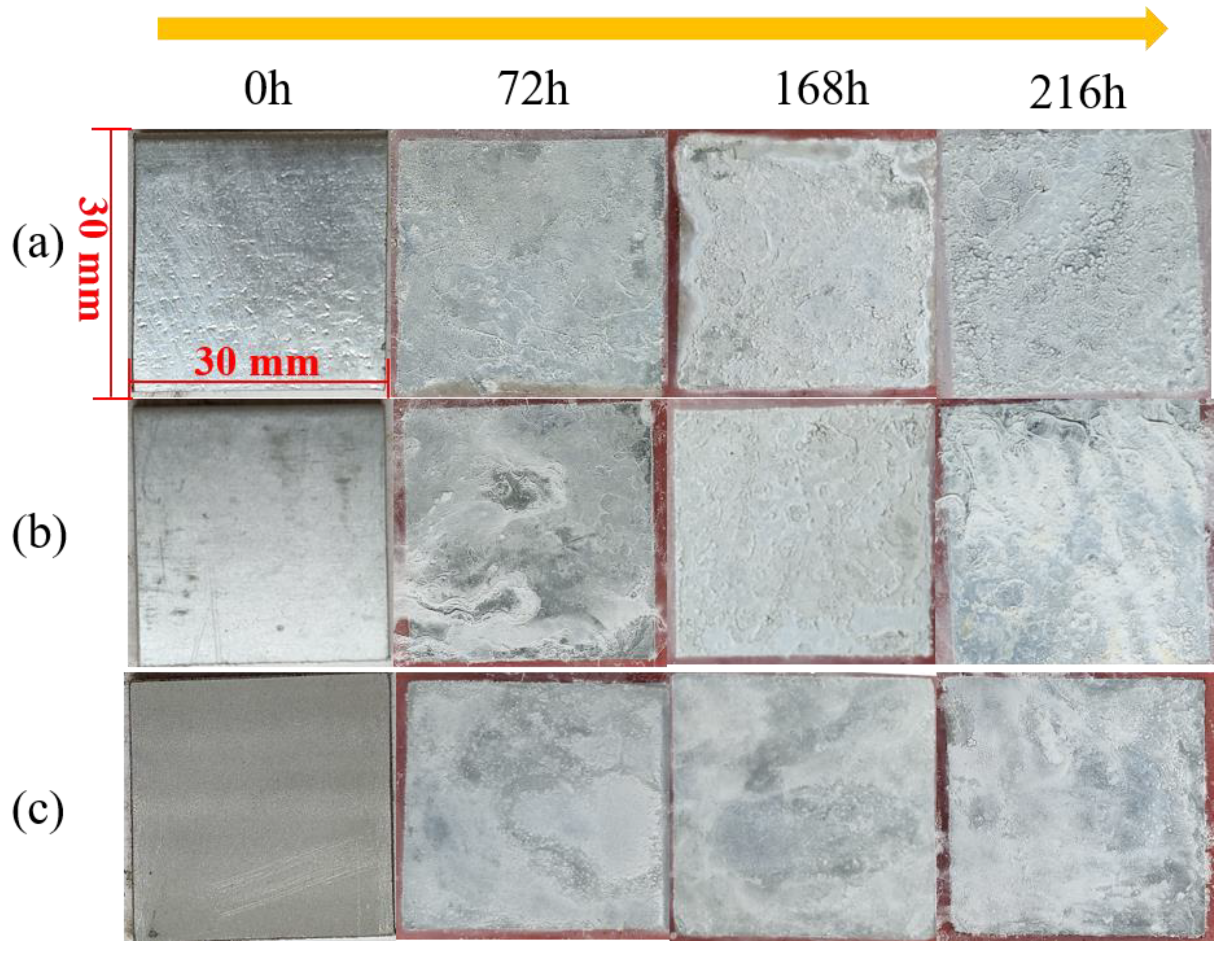
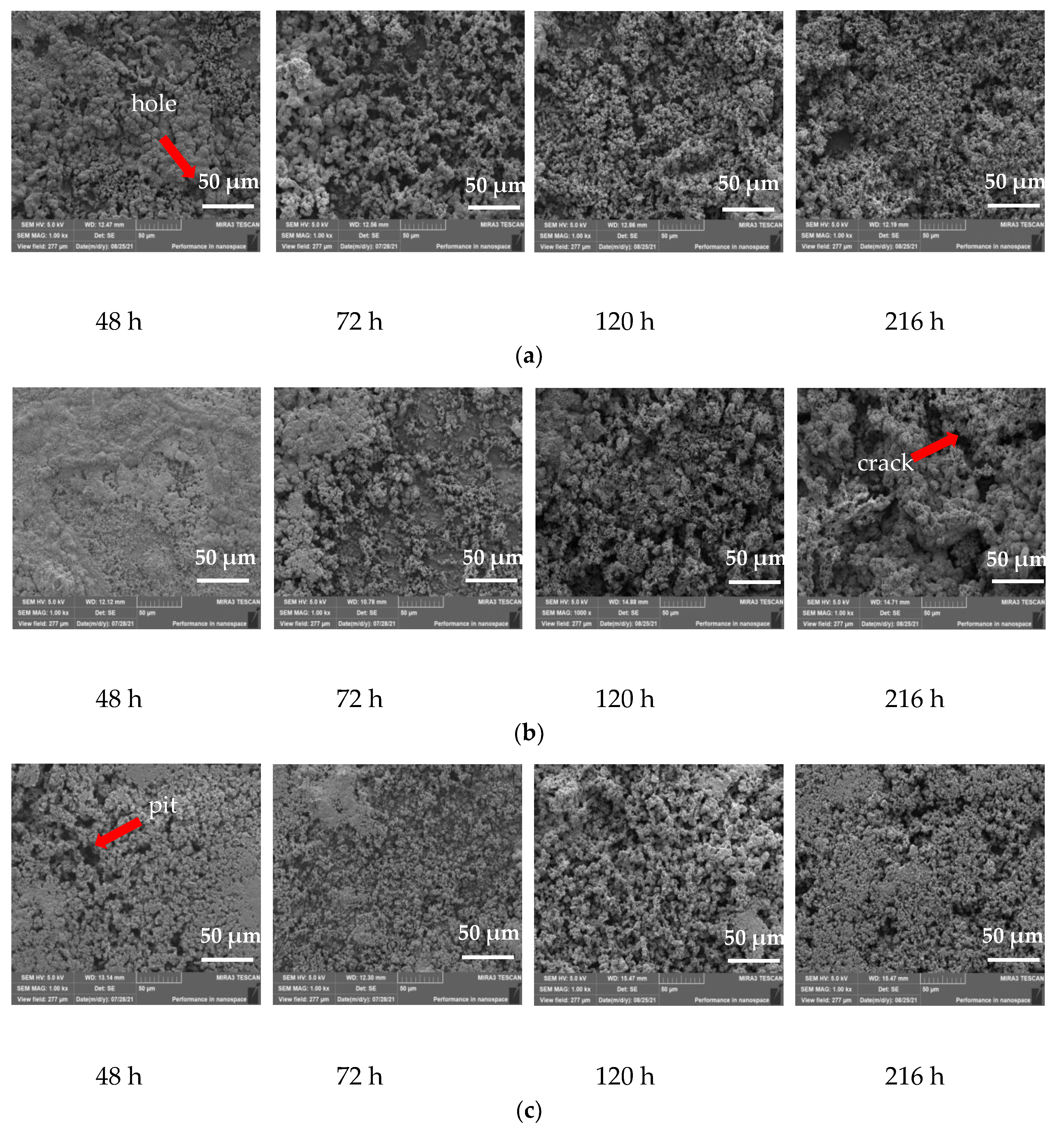
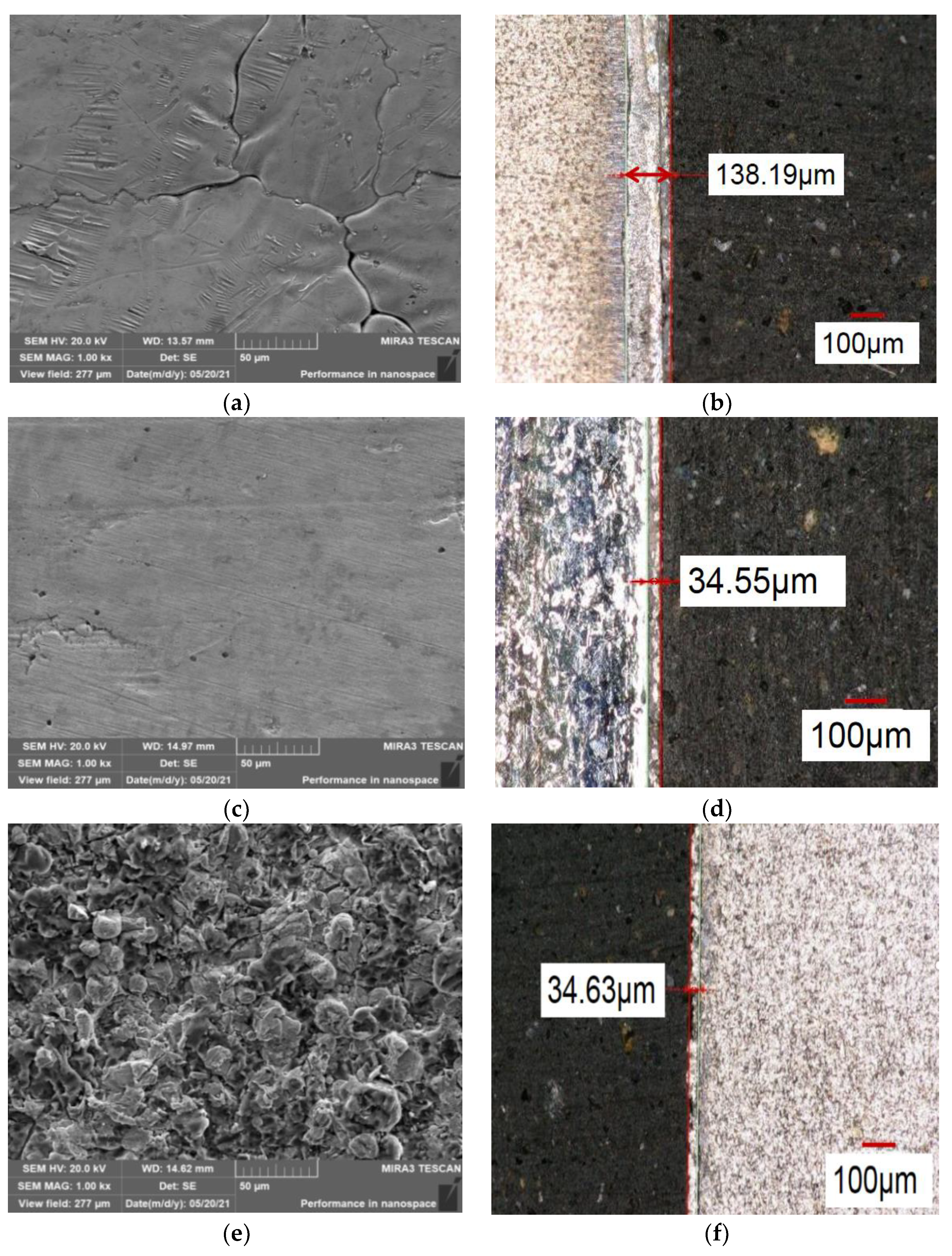


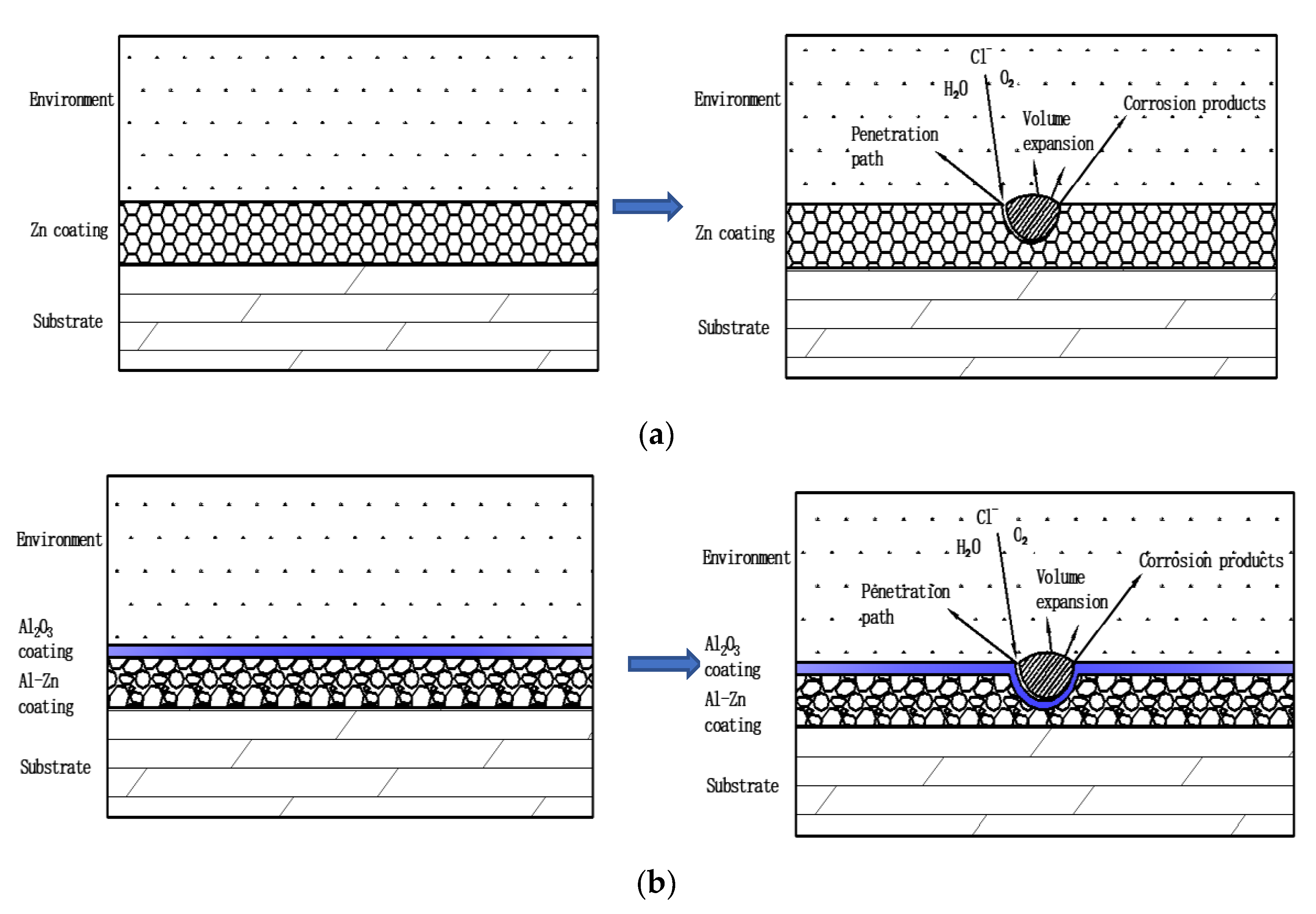


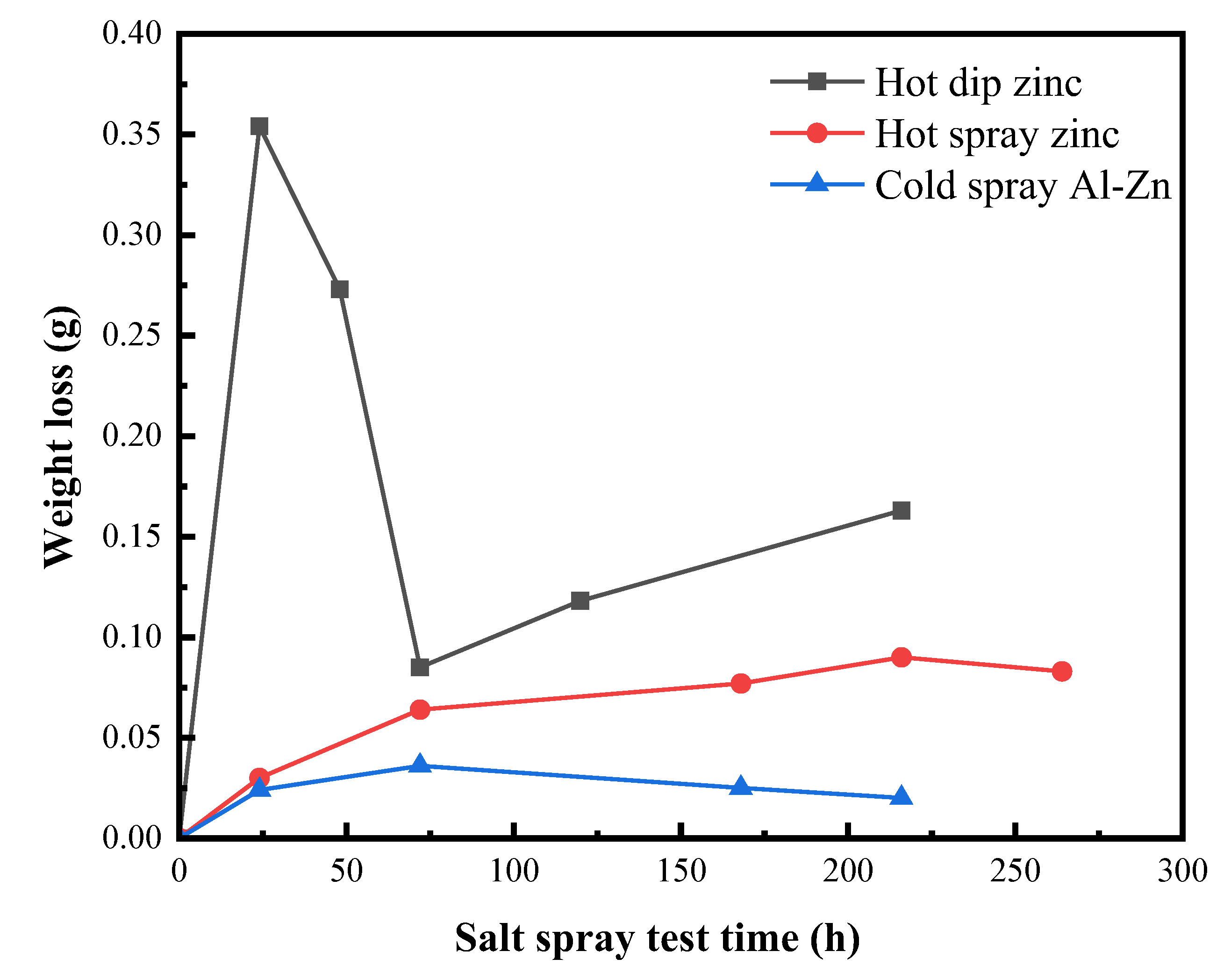

| Salt Spray Time/h | E/V | (i/A)/(A/cm2) |
|---|---|---|
| 0 | −1.34 | 1.58 × 10−4 |
| 24 | −1.46 | 2.32 × 10−4 |
| 48 | −1.32 | 3.69 × 10−4 |
| 72 | −1.32 | 3.88 × 10−4 |
| 120 | −1.33 | 3.67 × 10−4 |
| 216 | −1.33 | 2.93 × 10−4 |
| Salt Spray Time/h | E/V | (i/A)/(A/cm2) |
|---|---|---|
| 0 | −1.33 | 9.33 × 10−5 |
| 24 | −1.34 | 1.80 × 10−4 |
| 72 | −1.34 | 3.77 × 10−4 |
| 168 | −1.39 | 3.84 × 10−4 |
| 216 | −1.33 | 4.87 × 10−4 |
| 264 | −1.47 | 2.47 × 10−4 |
| Salt Spray Time/h | E/V | (i/A)/(A/cm2) |
|---|---|---|
| 0 | −1.36 | 5.75 × 10−5 |
| 24 | −1.44 | 1.22 × 10−4 |
| 72 | −1.53 | 4.56 × 10−4 |
| 168 | −1.34 | 1.36 × 10−4 |
| 216 | −1.33 | 2.43 × 10−4 |
Disclaimer/Publisher’s Note: The statements, opinions and data contained in all publications are solely those of the individual author(s) and contributor(s) and not of MDPI and/or the editor(s). MDPI and/or the editor(s) disclaim responsibility for any injury to people or property resulting from any ideas, methods, instructions or products referred to in the content. |
© 2023 by the authors. Licensee MDPI, Basel, Switzerland. This article is an open access article distributed under the terms and conditions of the Creative Commons Attribution (CC BY) license (https://creativecommons.org/licenses/by/4.0/).
Share and Cite
Chen, J.; Liu, J.; Wang, H.; Li, B.; Hu, Q.; Shao, T.; Yang, R.; Wang, B.; Wan, Q.; Li, Z.; et al. Experimental Study on Neutral Salt Spray Accelerated Corrosion of Metal Protective Coatings for Power-Transmission and Transformation Equipment. Coatings 2023, 13, 480. https://doi.org/10.3390/coatings13030480
Chen J, Liu J, Wang H, Li B, Hu Q, Shao T, Yang R, Wang B, Wan Q, Li Z, et al. Experimental Study on Neutral Salt Spray Accelerated Corrosion of Metal Protective Coatings for Power-Transmission and Transformation Equipment. Coatings. 2023; 13(3):480. https://doi.org/10.3390/coatings13030480
Chicago/Turabian StyleChen, Junwei, Jie Liu, Haobin Wang, Bo Li, Quan Hu, Tianjing Shao, Ruijing Yang, Bin Wang, Qiang Wan, Zhenggang Li, and et al. 2023. "Experimental Study on Neutral Salt Spray Accelerated Corrosion of Metal Protective Coatings for Power-Transmission and Transformation Equipment" Coatings 13, no. 3: 480. https://doi.org/10.3390/coatings13030480
APA StyleChen, J., Liu, J., Wang, H., Li, B., Hu, Q., Shao, T., Yang, R., Wang, B., Wan, Q., Li, Z., Lei, Y., Zhang, G., & Yang, B. (2023). Experimental Study on Neutral Salt Spray Accelerated Corrosion of Metal Protective Coatings for Power-Transmission and Transformation Equipment. Coatings, 13(3), 480. https://doi.org/10.3390/coatings13030480







